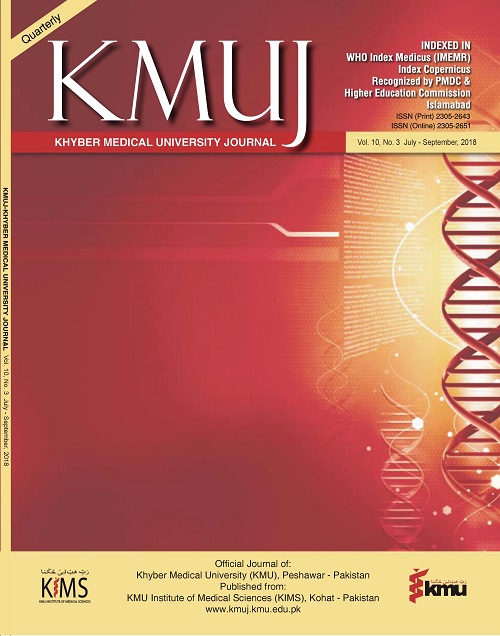DEVELOPMENT OF NAMING, READING, AND IMITATION SKILLS MANAGEMENT PROGRAMME FOR PATIENTS WITH BROCA’S APHASIA
Main Article Content
Abstract
ABSTRACT
OBJECTIVE: To develop the naming, reading and imitation skills management programme through mobile application of patients with severe Broca’s Aphasia.
METHODS: A pilot study with eight patients was carried out. Purposive non-probability sampling technique was used to recruit the patients with severe Broca’s aphasia who received therapy through mobile application. It contains three domains: naming, reading and imitation. The programme was developed in Urdu language. Study was conducted in Yusra General Hospital, Islamabad and Railway Hospital, Rawalpindi, Pakistan. The inclusion criteria were patients above age of 40 and three months of stroke with diagnosis of chronic Broca’s Aphasias, while patients with severe cognitive impairment were excluded. The pre and post score of patients was recorded. Treatment protocol included 30-45 mints sessions, 4 days per week for total of 8 weeks. Data for each patient was analyzed based on their pre and post intervention scores.
RESULTS: According to demographic variations 50.0% people lie in the age range 40-50 while 50.0% of people were 51-60 years. The mean age of sample was 49 years and 87% of participants were right handed. The pretest score on repetition was 16.25± 6.96 and post-test was 60.5±9.11 (p-value=0.000). The pretest score on naming was 49.75± 26.28 and post-test was 111.25±31.38 (p-value=0.000). The pretest reading score was 31.75±10.87 and post-test scores was 67.50±17.13 (p-value=0.000).
CONCLUSION: It is concluded from the results that the naming, reading and imitation skills improved in patients with severe Broca’s aphasia through management applications.
KEY WORDS: Aphasia (MeSH), Broca’s Aphasia (MeSH), Language Disorder (MeSH), Android management application (Non-MeSH)
Article Details
Work published in KMUJ is licensed under a
Creative Commons Attribution 4.0 License
Authors are permitted and encouraged to post their work online (e.g., in institutional repositories or on their website) prior to and during the submission process, as it can lead to productive exchanges, as well as earlier and greater citation of published work.
(e.g., in institutional repositories or on their website) prior to and during the submission process, as it can lead to productive exchanges, as well as earlier and greater citation of published work.
References
REFERENCES
Steele RD, Aftonomos LB, Munk MW. Evaluation and Treatment of Aphasia Among the Elderly with Stroke. Top Geriatr Rehabil 2003;19(2):98-108.
Davidson B, Howe T, Worrall L, Hickson L, Togher L. Social participation for older people with aphasia: the impact of communication disability on friendships. Top Stroke Rehab 2008;15(4):325-40. DOI: 10.1310/tsr1504-325
Bhogal SK, Teasell R, Speechley M. Intensity of aphasia therapy, impact on recovery. Stroke 2003;34(4):987-93. DOI: 10.1161/01.STR.0000062343.64383
Engelter ST, Gostynski M, Papa S, Frei M, Born C, Adjacic-Gross V, et al. Epidemiology of aphasia attributable to first ischemic stroke: incidence, severity, fluency, etiology and thrombolysis. Stroke 2006;37(6):1379-84. DOI: 10.1161/01.STR.0000221815.64093.8.
Donnan GA, Fisher M, Macleod M, Davis SM. Stroke. Lancet 2008;371(9624);1612-23. DOI: 10.1016/S0140-6736(08)60694-7
Dickey L, Kagan A, Lindsay MP, Fang J, Rowland A, Black S. Incidence and profile of inpatient stroke-induced aphasia in Ontario, Canada. Arch Phys Med Rehabil 2010;91(2):197-202. DOI: 10.1016/j.apmr.2009.09.020.
Benson DF, Dobkin BH, Rothi GLJ, Helm-Estabrooks N, Kertesz A. Assessment: Melodic intonation therapy Report of the Therapeutics and Technology Assessment Subcommittee of the American Academy of Neurology. Neurology 1994;44(3 Pt 1): 566-8.
Albert ML. Treatment of aphasia. Arch Neurol 1998;55(11):1417-9. DOI: 10.1001/archneur.55.11.1417
Davis GA, Wilcox ML. Adult aphasia rehabilitation: Applied pragmatics. College Hill Press 1985.
Manasco MH. Introduction to Neurogenic Communication Disorders. Jones & Bartlett Learning 2014.
Palmer R, Enderby P, Cooper C, Latimer N, Julious S, Paterson G, et al. Computer therapy compared with usual care for people with long-standing aphasia poststroke: a pilot randomized controlled trial. Stroke 2012;43(7):1904-11. DOI: 10.1161/STROKEAHA.112.650671.
Snodgrass JG, Vanderwart M. A standardized set of 260 pictures: norms for name agreement, image agreement, familiarity, and visual complexity. J Exp Psychol Hum Learn 1980;6(2):174-215.
Archibald LM, Orange JB, Jamieson DJ. Implementation of computer-based language therapy in aphasia. Ther Adv Neurol Disord 2009;2(5):299-311. DOI: 10.1177/1756285609336548.
Katz RC, Wertz RT. The efficacy of computer-provided reading treatment for chronic aphasic adults. J Speech Lang Hearing Res 1997;40(3):493-507. DOI: 10.1044/jslhr.4003.493
Pulvermuller F, Berthier ML. Aphasia therapy on a neuroscience basis. Aphasiology 2008;22(6):563-99. DOI: 10.1080/02687030701612213
Pedersen PM, Vinter K, Olsen TS. Improvement of oral naming by unsupervised computerised rehabilitation. Aphasiology 2001;15(2):151-69. DOI: 10.1080/02687040042000106.
